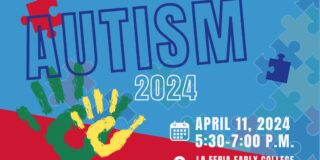- Groundbreaking Ceremony Held for New Airport Tower
- School District Places 1st in It’s Time Texas Community Challenge
- Students of the Month
- The First Jiu-Jitsu Gym in La Feria!
- La Feria Native Soon To Retire From The Military This Summer
- Senior Eneece Avila Takes Pride in her State Title
- Dr. Noemi Infante, Harlingen Medical Center Open New Women’s Clinic
- Santa Rosa Cameron County Park Partially Reopens
- Santa Rosa Takes to Regionals Meet in Kingsville, Tx
- Long-Standing Nexstar Tower in La Feria Decommissioned
Gravitational Waves Detected 100 Years After Einstein’s Prediction
- Updated: February 23, 2016
UTRGV’s CGWA Scientists Contribute with Nearly 20 Years of Gravitational Wave Research
WASHINGTON, D.C. / RIO GRANDE VALLEY, TEXAS – For the first time, scientists have observed ripples in the fabric of spacetime called gravitational waves, arriving at the earth from a cataclysmic event in the distant universe.
This confirms a major prediction of Albert Einstein’s 1915 general theory of relativity, and opens an unprecedented new window onto the cosmos.
Gravitational waves carry information about their dramatic origins and about the nature of gravity that cannot otherwise be obtained. Physicists have concluded that the detected gravitational waves were produced during the final fraction of a second of the merger of two black holes to produce a single, more massive spinning black hole. This collision of two black holes had been predicted, but never observed.
The gravitational waves were detected at 5:51 a.m. (EDT) on Sept. 14, 2015, by both of the twin Laser Interferometer Gravitational-wave Observatory (LIGO) detectors, located in Livingston, Louisiana, and Hanford, Washington. The LIGO Observatories are funded by the National Science Foundation (NSF), and were conceived, built and are operated by Caltech and MIT.
The discovery, accepted for publication in the journal Physical Review Letters, was made by the LIGO Scientific Collaboration (which includes the GEO Collaboration and the Australian Consortium for Interferometric Gravitational Astronomy) and the Virgo Collaboration, using data from the two LIGO detectors.
LIGO originally was proposed as a means of detecting these gravitational waves in the 1980s by Rainer Weiss, professor of physics, emeritus, from MIT; Kip Thorne, Caltech’s Richard P. Feynman Professor of Theoretical Physics, emeritus; and Ronald Drever, professor of physics, emeritus, also from Caltech.
LIGO research is carried out by the LIGO Scientific Collaboration, a group of more than 1,000 scientists from universities around the United States — including The University of Texas Rio Grande Valley — and in 14 other countries.
CONTRIBUTIONS BY UTRGV SCIENTISTS AND STUDENTS TO THE DISCOVERY OF GRAVITATIONAL WAVES
The University of Texas Rio Grande Valley houses the Center for Gravitational Wave Astronomy – founded in 2003 with grants from the National Aeronautic Space Administration and the National Science Foundation.
The UTRGV CGWA has the largest group of gravitational-wave researchers in Texas and is one of the largest from the United States involved in the LIGO Scientific Collaboration (LSC) global research effort. Its scientists and student researchers are key contributors to the first direct detection of gravitational waves; more than 20 authors on the detection paper to be published by Physical Review Letters are current or past members of the CGWA.
“This is a major scientific triumph and testimony to the persistence and courage of scientists who never gave up,” said Dr. Mario Díaz, CGWA director. “Never before in the history of modern physics has a predicted phenomenon been so elusive and taken so long to be observed experimentally. It is also a tribute to the scientific vision of The University of Texas that has supported the CGWA for all these years.”
· CGWA Professor Malik Rakhmanov has been with the LIGO project since 1995, and spent many years at the detector sites installing hardware and commissioning the detectors. He started the experimental research lab focused on optical and interferometric research when he joined the CGWA in 2008.
· CGWA Professor Volker Quetschke started working on gravitational-wave detector hardware in 2000 and has been a member of the CGWA since 2009. His efforts include research on the laser system, especially its stabilization, the electro-optic modulators, as well as the interface between the in-air laser system with the in-vacuum interferometer.
· Drs. Rakhmanov and Quetschke, together with LIGO Hanford senior scientist and CGWA Adjunct Professor Richard Savage, have led an active and very fruitful collaboration between the CGWA and the LIGO Hanford Observatory for more than seven years. Students have worked at the site, directly contributing to the success of LIGO. These students include Sergio Cantu, Pablo Daveloza, Gregorio Tellez, Andrea Tellez, postdoctoral researcher Dr. Oliver Puncken and current doctoral students Darkhan Tuyenbayev and Guillermo Valdes, who are active LSC fellows participating in commissioning and detector characterization. Doctoral student Karla Ramirez will be joining them in the summer.
· The algorithm that first detected the event is based on work done by CGWA Professors Soumya Mohanty and Rakhmanov in collaboration with Professors Sergey Klimenko and Guenakh Mitselmakher from the University of Florida.
· Former members of the CGWA, Manuela Campanelli, Carlos Lousto and Yosef Zlochower (currently at RIT), were instrumental in the numerical modeling of the merger of a pair of black holes, producing waveforms that match that of the detected event.
· CGWA scientists Mario Diaz, Matt Benacquista, Tania Peñuela and doctoral student Martin Beroiz led an international collaboration that operated optical telescopes in the southern hemisphere to perform a follow-up search in the hours immediately after the event, looking for possible visible but faint counterparts in the sky. The group from the UTRGV CGWA was one of only 20 groups of astronomers throughout the world who performed this follow-up.
· CGWA Professor Teviet Creighton has also participated actively in developing and reviewing algorithms searching for gravitational waves associated with neutron stars.
· CGWA Professor Joseph Romano, who with Professor Mario Diaz is a co-founder of the CGWA, has led efforts in developing techniques to detect the gravitational waves of cosmological origin associated with the Big Bang.
· CGWA Professor Soma Mukherjee, chair of the UTRGV Department of Physics, has contributed to several aspects of detector noise analysis and searches for gravitational-wave signals from supernovae.
· Graduate students Sean Morriss, Marc Normandin and Robert Stone, CGWA Research Assistant Professor Joey Shapiro Key, and former CGWA Research Assistant Professor Cristina Torres, have been involved in LIGO data analysis and detector characterization.
UTRGV Founding President Guy Bailey said he is proud of everyone involved in this critical discovery.
“This is a wonderful testament to the dedication and excellence of our CGWA faculty and students and their research collaborations. It also provides pivotal groundwork for the university’s commitment to future research endeavors. We congratulate our entire CGWA team on its role in this impressive scientific collaboration.”
CGWA EDUCATION AND OUTREACH
In addition to research, the CGWA leads local, national and international education and outreach efforts in gravitational-wave astronomy. The CGWA Director of Education and Outreach, Dr. Joey Shapiro Key, serves as the LSC Education and Public Outreach Committee Chair. CGWA faculty host undergraduate physics students from across the country and local high school physics teachers for summer research in the NSF-funded Research Experience for undergraduates and Research Experience for Teachers programs.
In Brownsville, the CGWA hosts monthly public telescope viewings at Resaca de la Palma State Park, where a new astronomical observatory built by the CGWA is finishing completion and will be inaugurated soon; monthly Science Cafe events at El Hueso de Fraile in downtown Brownsville; Physics Circus performances for schools and community groups; and the annual Rio Grande Science and Arts (RiSA) Festival.
Members of the CGWA are also involved in other gravitational detection projects, including the North American Nanohertz Observatory for Gravitational Waves (NANOGrav) and the Laser Interferometer Space Antenna (LISA).
LIGO RESEARCH AND THE LIGO SCIENTIFIC COLLABORATION
The LIGO Scientific Collaboration (LSC) is a group of more than 1,000 scientists from universities around the United States and in 14 other countries. More than 90 universities and research institutes in the LSC develop detector technology and analyze data; approximately 250 students are strong contributing members of the collaboration. The LSC detector network includes the LIGO interferometers and the GEO600 detector. The GEO team includes scientists at the Max Planck Institute for Gravitational Physics (Albert Einstein Institute, AEI), Leibniz Universität Hannover, along with partners at the University of Glasgow, Cardiff University, the University of Birmingham, other universities in the United Kingdom, and the University of the Balearic Islands in Spain.
Virgo research is carried out by the Virgo Collaboration, consisting of more than 250 physicists and engineers belonging to 19 different European research groups: six from Centre National de la Recherche Scientifique(CNRS) in France; eight from the Istituto Nazionale di Fisica Nucleare (INFN) in Italy; two in The Netherlands with Nikhef; the Wigner RCP in Hungary; the POLGRAW group in Poland; and the European Gravitational Observatory (EGO), the laboratory hosting the Virgo detector near Pisa in Italy.
The discovery was made possible by the enhanced capabilities of Advanced LIGO, a major upgrade that increases the sensitivity of the instruments compared to the first generation LIGO detectors, enabling a large increase in the volume of the universe probed – and the discovery of gravitational waves during its first observation run.
The US National Science Foundation leads in financial support for Advanced LIGO. Funding organizations in Germany (Max Planck Society), the U.K. (Science and Technology Facilities Council, STFC) and Australia (Australian Research Council) also have made significant commitments to the project. Several of the key technologies that made Advanced LIGO so much more sensitive have been developed and tested by the German UK GEO collaboration. Significant computer resources have been contributed by the AEI Hannover Atlas Cluster, the LIGO Laboratory, Syracuse University, and the University of Wisconsin-Milwaukee. Several universities designed, built, and tested key components for Advanced LIGO: The Australian National University, the University of Adelaide, the University of Florida, Stanford University, Columbia University in the City of New York, and Louisiana State University.
For more information about the CGWA and the first direct detection of gravitational waves, go to http://www.utrgv.edu/cgwa and http://www.ligo.org.

![BBH1[1]](https://laferianews.net/wp-content/uploads/2016/02/BBH11.jpg)





